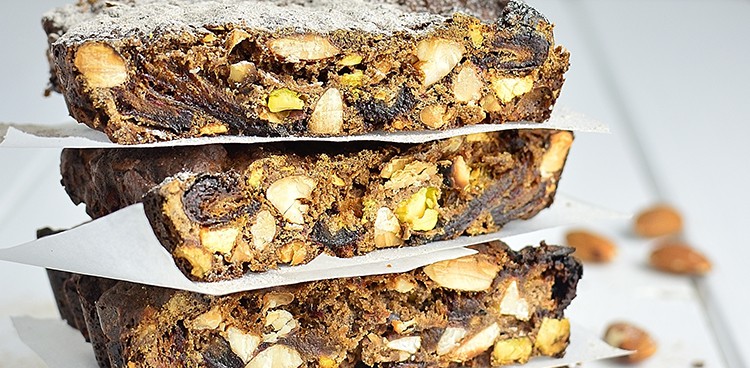
The Great 28 was featured in our Cheese+ 2017 issue. Check out 27 other pairings here.
It’s a New Year’s tradition: In early January citizens of Manitou Springs, Colo., gather in a park armed with the fruitcakes they received during the holiday season. There, in the shadow of the Rocky Mountains, locals toss the cakes—by hand, by slingshot, by pressurized air gun, even by cannon—hoping to win the year’s trophy for the farthest-flung confection.
Oh fruitcake, where did you go wrong? Maybe it was the moment somebody decided to sprinkle you with fluorescent candied fruits. Or perhaps it was in 1985, when talk-show host Johnny Carson dubbed you “the worst gift.” (“There is only one fruitcake in the world,” he quipped, “and people keep sending it to each other.”)
But love ’em or hate ’em, these dense, divisive desserts shine alongside cheese. After all, the two foods have something in common—they’re both ancient preservation methods.
From the Romans to the Crusaders, troops munched on spoil-safe patties made from dried fruit, barley mash, wine, honey, and nuts during long journeys. From these early cakes sprang a family tree of European varieties, expensive and labor-intensive mixtures that were aged just in time for holiday feasts.
And old world or new, fruitcakes are achingly sweet—which is another reason they’re ideal alongside our favorite salty snack. The pairing is logical, says Jane Stammers, head cook at Sheffield, U.K.–based fruitcake company Tipple Tails. “If you’re happy eating fruits and nuts with cheese, it’s not difficult to see why fruitcake works so well.”
Yorkshire Christmas Cake
This version may be the most likely predecessor to our Technicolor incarnation, but don’t blame the British. Traditional Yorkshire Christmas cake is darker, jam-packed with raisins and currants, and full of flavor. Ideally made at least four weeks before the holidays, loaves are wrapped in brandy-soaked cheesecloth, which is then periodically resoaked and rewrapped so the cake slowly ages, absorbing the alcohol. “The flavor develops with maturation,” says Ursula Evans, author of the cookbook Fruitcake (Middle Farm Press, 2015), which offers 60 variations on the British original.
In the north of England, “Christmas cakes” have long been matched with wedges. “The pairing seems traceable at least to the Victorian era in Yorkshire,” says Andy Swinscoe, owner of The Courtyard Dairy shop in Settle, U.K., which sells curated cheese and fruitcake combos. Northern English wheels with a sharp finish and crumbly texture are the usual picks, with their “lactic bite that offsets the rich, dense, figgy, curranty notes of a proper boozy fruitcake,” Swinscoe says. For cakes with a higher concentration of cherries or other red fruits, try a creamier, more pungent cheese, such as a Stilton. (Bonus: Its peppery notes complement the ginger and nutmeg in the fruitcake.)
Recommended Pairings
Fortmayne Dairy Richard III Wensleydale + traditional Christmas cake
Stichelton Dairy Stichelton + The Fortnum’s Fruit Cake
Panforte
“Some people call panforte the ultimate PowerBar,” says Janice Thomas, owner of Wisconsin-based confectioner Savory Spoon. She’s been making the dense, fudgy treat since a trip to Siena, Italy, where it’s been a staple since the 13th century. Indeed, what this fruitcake lacks in flour it makes up for in dried fruits such as prunes, apricots, and figs, with a generous helping of sugar and honey that ups the sweetness considerably. That’s why Thomas opts for a balancing salty blue. Offer little nuggets of the cake, “about the size of a pencil eraser,” on a cheese plate, she suggests. For a more traditional approach, match panforte’s sweetness and nuttiness with that of an aged sheep’s milk cheese from the same region.
Recommended Pairings
Roelli Cheese Company Dunbarton Blue + Savory Spoon Panforte
Fattoria Buca Nuova Pecorino di Pienza + Panforte di Siena IGP
Pan de Higo
Spain’s Valencians developed a decidedly simpler version made almost entirely of figs and almonds (occasionally punched up with honey, brandy, or spices). It’s extradense, dark, and tannic, exploding with molasses flavors. When paired with a Malvarosa, an aged sheep’s milk wheel also from Valencia, the fig’s toasty sweet-ness matches the butterscotch undertones of the cheese and brings buttery flavors to the fore. Caseophiles more partial to textural contrast should smother a thin slice of chewy pan de higo with soft, creamy bûcheron. (Who doesn’t love figs with soft-ripened goat cheese?)
Recommended Pairings
Granja Rinya Malvarosa + pan de higo
Sèvre et Belle Bûcheron + pan de higo
Feature Photo Credit: Tayana Malova/Shutterstock.com



